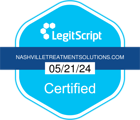Two common options that often cause confusion are sober living homes and halfway houses. While both provide structured, substance-free environments, they serve different purposes and populations in the recovery process.
At Nashville Treatment Solutions, we understand that choosing the right housing can make or break your recovery journey. Let’s explore the key differences between these two options to help you make the best decision for your unique situation.
Learn more about our addiction treatment programs or call us now at
What is a Sober Living Home?
Sober living homes, also known as sober living houses or transitional living facilities, are private residences designed to provide a supportive, drug and alcohol-free environment for individuals in recovery. These homes serve as a bridge between intensive treatment programs and independent living.
Key Characteristics of Sober Living Homes:
Voluntary Participation: Residents choose to live in sober living homes as part of their personal recovery plan. There are no court mandates or legal requirements forcing participation.
Flexible Stay Duration: Residents can typically stay as long as they need, with many choosing to remain for several months to over a year. The length of stay is determined by individual progress and circumstances.
Peer-Driven Support: These homes operate on a peer-support model where residents support each other through shared experiences and accountability.
House Rules and Structure: While less restrictive than treatment facilities, sober living homes maintain house rules including mandatory drug testing, curfews, chore assignments, and participation in house meetings.
Employment and Education Focus: Residents are encouraged or required to work, attend school, or participate in vocational training programs.
12-Step Program Integration: Many sober living homes encourage participation in AA, NA, or other recovery support groups.
What is a Halfway House?
Halfway houses are transitional living facilities primarily designed for individuals who are re-entering society after incarceration or completing court-mandated treatment programs. The term “halfway” refers to being halfway between institutional living and complete independence.
Key Characteristics of Halfway Houses:
Government or Court-Mandated: Most halfway house residents are there as a requirement of their parole, probation, or as an alternative to incarceration.
Shorter Stay Duration: Stays are typically limited to 3-12 months, as determined by legal requirements or program guidelines.
Stricter Supervision: Halfway houses operate under more stringent oversight, often with staff monitoring residents around the clock and strict accountability measures.
Diverse Population: While some residents may be in recovery from addiction, others may be there solely due to criminal justice requirements, creating a more diverse population with varying needs.
Structured Programming: These facilities often provide or require participation in job training, counseling, life skills programs, and community service.
Legal Compliance Focus: The primary goal is ensuring residents meet their legal obligations and successfully reintegrate into society.
The Key Differences
1. Population and Admission Requirements
Sober Living: Primarily serves individuals voluntarily seeking recovery support. Residents typically have some period of initial sobriety and are motivated to maintain their recovery.
Halfway House: Serves individuals mandated by the criminal justice system, which may include those with substance use disorders, but also those with other legal issues unrelated to addiction.
2. Level of Supervision
Sober Living: Operates with minimal staff oversight, relying heavily on peer accountability and self-governance. House managers may be in recovery themselves.
Halfway House: Features professional staff supervision with formal case management, regular check-ins with probation officers, and structured programming requirements.
3. Treatment Integration
Sober Living: Residents often participate in outpatient treatment programs, therapy, or support groups in the community while living in the home.
Halfway House: May provide on-site programming or connect residents with required services, but the focus extends beyond addiction treatment to include general reintegration services.
4. Cost and Funding
Sober Living: Typically privately funded through resident fees, ranging from $500-$2,000 per month depending on location and amenities.
Halfway House: Often government-funded or subsidized, with costs covered by the criminal justice system or social services.
5. Rules and Restrictions
Sober Living: House rules focus primarily on maintaining sobriety, contributing to the household, and supporting fellow residents.
Halfway House: Rules are more comprehensive, covering legal compliance, curfews, employment requirements, and various behavioral expectations mandated by the court system.
Which Option is Right for You?
Choose Sober Living If:
- You’re voluntarily seeking recovery support
- You’ve completed initial treatment and want to transition gradually to independent living
- You’re employed or seeking employment
- You want a peer-support focused environment
- You have the financial means to pay for housing
- You’re committed to maintaining sobriety and supporting others in their recovery
Consider a Halfway House If:
- You’re required to live in transitional housing as part of legal obligations
- You’re re-entering society after incarceration
- You need comprehensive case management and structured programming
- You require assistance with basic life skills and job training
- You’re court-mandated to participate in a transitional program
Making the Right Choice for Your Recovery
The decision between sober living and halfway house accommodation should align with your individual circumstances, recovery stage, and personal goals. Consider these factors:
Your Recovery Stage: If you’re early in recovery, you might benefit from the structured support of either option. Those with more stable sobriety might prefer the flexibility of sober living.
Financial Resources: Determine what you can afford and what funding options are available to you.
Legal Requirements: If you have court mandates, a halfway house might be your required option.
Support System: Consider whether you need professional case management or prefer peer-led support.
Personal Goals: Think about your employment, education, and relationship goals and which environment would best support these objectives.
The Nashville Treatment Solutions Advantage
At Nashville Treatment Solutions, we understand that recovery housing is just one piece of your comprehensive treatment plan. We work closely with both sober living homes and transitional facilities throughout the Nashville area to ensure our clients have access to appropriate housing options that support their recovery goals.
Our team can help you:
- Assess your housing needs based on your recovery stage and personal circumstances
- Connect you with reputable sober living homes in the Nashville area
- Coordinate your housing with your ongoing treatment plan
- Provide support and guidance throughout your transition to independent living
Find Sober Living in Nashville Today
Whether you choose sober living or find yourself in a halfway house situation, remember that your housing is a tool to support your recovery, not define it. Success in either environment depends on your commitment to sobriety, willingness to engage with the community, and dedication to personal growth.
Recovery is not a destination but a lifelong journey. The right housing environment can provide the stability, support, and accountability you need to build a strong foundation for lasting sobriety. At Nashville Treatment Solutions, we’re here to support you every step of the way.
If you’re considering your housing options or need guidance on the next steps in your recovery journey, contact Nashville Treatment Solutions today. Our experienced team is ready to help you make informed decisions that support your long-term success and well-being.
Remember: Recovery looks different for everyone. What matters most is finding the environment and support system that works best for your unique situation and goals.








